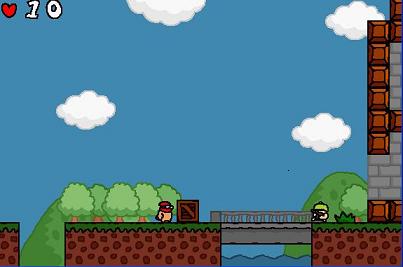
- 短跑(dash) – 快速按两次左/右方向键
- 空中滑行(glide) – 短跑之后跳跃
- 刹住(skid) – 滑行之后,按下相反的方向键
- 反跳(reverse jump) – 刹住之后跳跃
- 身体冲浪(body surf)- 在高处使出空中滑行,然后按住 Shift
我觉得最有用的就是反跳,但恰恰按键最复杂。如向前反跳为:快速按两次右方向键,马上再按一次左方向键,再按Shift。这一连串按键需一气呵成,我等懒人实在没办法只能借助Python的威力搞定这些按键了。
基本思路是Hook键盘keyup事件,然后用Win32 API SendInput或keybd_event函数模拟键盘输入,需要的Python第三方库有:pywin32、pyHook。
具体实现是用’z’键作向前反跳,用’x’键作向后反跳。
import time
import win32gui
import win32api
import win32con
import pyHook
# global
g_hwndWind = None
def SimulateKey(vk, t = 0.05):
scan = win32api.MapVirtualKey(vk, 0)
# down
win32api.keybd_event(vk, scan, 0, 0)
time.sleep(t)
# up
win32api.keybd_event(vk, scan, win32con.KEYEVENTF_KEYUP, 0)
# simulate time delay
time.sleep(0.05)
def OnKeyboardEvent(event):
global g_hwndWind
print event.MessageName
if event.Window == g_hwndWind:
if event.Ascii == ord(‘z’):
# ‘z’ simulate jump back (right+right+left+shift)
SimulateKey(win32con.VK_RIGHT)
SimulateKey(win32con.VK_RIGHT)
SimulateKey(win32con.VK_LEFT)
SimulateKey(win32con.VK_SHIFT, 0.5)
elif event.Ascii == ord(‘x’):
# ‘x’ simulate jump front
SimulateKey(win32con.VK_LEFT)
SimulateKey(win32con.VK_LEFT)
SimulateKey(win32con.VK_RIGHT)
SimulateKey(win32con.VK_SHIFT, 0.5)
return True
def main():
try:
# find teppoman2 window handle
global g_hwndWind
g_hwndWind = win32gui.FindWindow(“Mf2MainClassTh”, “偰偭傐儅儞俀”)
# create the hook mananger
hm = pyHook.HookManager()
hm.KeyUp = OnKeyboardEvent
# hook into the and keyboard events
hm.HookKeyboard()
# message poll
win32gui.PumpMessages()
except:
print “can’t find window”
if __name__ == “__main__”:
main()
